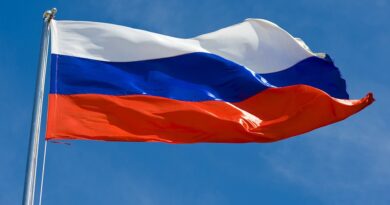After Trump’s win, Russian disinformation aims to drive a wedge between the US and Ukraine
WASHINGTON — As President Joe Biden uses his final days in office to boost Ukraine’s defenses, Russia is playing a different game: spreading disinformation aimed at eroding U.S. support for Ukraine before Donald Trump’s return to the White House next month.

Russian President Vladimir Putin speaks during a plenary session of a VTB Investment Forum on Dec. 4 in Moscow.
Since the U.S. election on Nov. 5, the Kremlin has used state-run media and its networks of fake news sites and social media accounts to push divisive narratives about the war and America’s Republican president-elect. Analysts say the content, translated into English for American audiences, is intended to turn sentiment against Ukraine at a pivotal time, with the hope of reducing U.S. military assistance and ensuring a Russian victory.
Recent examples include fake videos supposedly showing Ukrainian soldiers burning effigies of Trump or his supporters. One clip depicts soldiers saying Trump must not be allowed to take office and should “never be president again.” Multiple researchers have debunked the video, noting telltale signs of digital manipulation.
People are also reading…
A different video claims to show Ukrainian soldiers firing at a mannequin wearing a red “Make America Great Again” hat and a Trump campaign shirt. That video was analyzed and determined to be fake by private analysts and Ukraine’s Center for Countering Disinformation, a government agency that tracks Kremlin propaganda.

Republican presidential nominee former President Donald Trump signs autographs as Massad Boulos listens during a visit to The Great Commoner on Nov. 1 in Dearborn, Mich.
Other versions — just as fake — depict Ukrainian soldiers burning Trump’s books or calling him a coward. In the weeks after the election, the clips spread far beyond Ukraine and Russia, circulating among Trump supporters and believers in QAnon, the conspiracy theory that claims Trump is fighting a war against a Satanic cabal of powerful world leaders.
It’s part of Russia’s continued push to divide Americans over the nearly 3-year war in Ukraine and paint Ukrainians as unreliable, dishonest allies, according to analysts who have tracked Russian disinformation and propaganda since the war began. By discouraging American support for Ukraine, the Kremlin is hoping to cut off the most vital source of military assistance that has kept Ukrainian hopes alive since Russia invaded in February 2022.
CNN’s Fred Pleitgen sat down for a wide-ranging exclusive interview with Sergei Ryabkov, Russia’s deputy foreign minister.
Early in the war, Russian propagandists portrayed Ukrainian leaders as corrupt and self-serving. Russian state media claimed Ukraine’s leaders held Nazi sympathies — even though President Volodymyr Zelenskyy is Jewish — or were involved in clandestine bioweapons research that Moscow sought to tie to the COVID-19 pandemic. Each false claim was used to justify Russia’s invasion.
“It’s planted by the Russians, this idea that ‘Ukraine is so corrupt it shouldn’t even be a state, and we are the right people to be running this place,’” said Rupert Smith, a retired British general and former NATO deputy supreme commander who now leads a Brussels-based consulting firm called Solvo Partners. “Now this is being used as an excuse for not supporting Ukraine.”
The fake video claiming to show Ukrainian soldiers firing on the Trump mannequin spread on platforms such as X, Telegram and YouTube, getting an early boost from pro-Kremlin news sites before migrating to ones popular with Americans, according to an analysis by researchers at NewsGuard, a firm that tracks disinformation.
Some versions of the video were created long before the election but were passed off as more recent. Within days, the video was receiving hundreds of thousands of views and had been translated into several languages besides Russian and English, including German, Chinese and Polish, NewsGuard found.
According to U.S. intelligence, Russia sought to support Trump in the presidential election, believing he would reduce American backing for Ukraine and perhaps the NATO alliance. The incoming president has praised Russian President Vladimir Putin, criticized U.S. military aid to Ukraine and NATO and promised to end the war in 24 hours, comments that appear to suggest he would press Ukraine to surrender territory now occupied by Russia.
In response to questions about Russia’s role in spreading disinformation about Ukraine, a spokesperson for the Russian Embassy in Washington referred to past statements rejecting any involvement.

President Joe Biden leaves the National Museum of Slavery on Tuesday in the capital Luanda, Angola.
In the time it has left, the Biden administration has urged Ukraine to quickly increase the size of its military by drafting more troops and has stepped up weapons shipments while forgiving billions in loans provided to Kyiv. So far, the White House has pushed more than $56 billion in security assistance to Ukraine and expects to send billions more before Biden leaves office on Jan. 20, 2025.
It’s easy to understand Russia’s motives in trying to cut off that supply of aid, said Joshua Tucker, a New York University professor and Russia expert who studies online disinformation. What’s harder to gauge, he said, is the effectiveness of Russian disinformation, especially on social media platforms already crowded with false, bizarre and debunked claims.
One reason that Russia may persist with disinformation targeting Americans is the relative ease and affordability of such operations compared with diplomatic or military alternatives.
Russia likely sees disinformation as part of a long-term effort to undermine America’s global leadership by dividing its people and undermining support for its institutions, Tucker said. Whether the topic is immigration, the government, the U.S. economy or the war in Ukraine, he said, the goal remains the same and goes beyond one election cycle or one candidate.
“I think what they were really hoping for is a contested result with lots of people out in the streets, arguing the election wasn’t legitimate,” Tucker said.
If they couldn’t have that, however, Russia’s disinformation agencies will keep pushing narratives that they believe will inflame Americans and boost their chances in Ukraine, Tucker said.
1,000 days of war in Ukraine captured in images

Refugees fleeing war in neighboring Ukraine queue up March 10, 2022, at the Medyka border crossing, Poland.

Firefighters extinguish a fire Feb. 10, 2024, after a Russian attack on a residential neighborhood in Kharkiv, Ukraine.

A man runs while recovering items from a burning shop March 25, 2022, following a Russian attack in Kharkiv, Ukraine.

People help Liudmila, 85, into a bus May 12, 2024, after their evacuation from Vovchansk, Ukraine.

Ukrainian soldiers of the 3rd assault brigade fly an FPV exploding drone Aug. 25, 2024, over Russian positions in Kharkiv region, Ukraine.

Relatives and friends pay their last respects to Liza, a 4-year-old girl killed by a Russian attack, during a July 17, 2022, mourning ceremony in an Orthodox church in Vinnytsia, Ukraine.

Young cadets get ready for a ceremony in a cadet lyceum on Sept. 2, 2024, the first day of school, in Kyiv, Ukraine.

Stanislav, an injured Russian prisoner of war, lies in bed April 25, 2024, at the detention center in Ukraine’s Lviv region.

Ukrainian emergency employees and police officers evacuate injured pregnant woman Iryna Kalinina, 32, from a maternity hospital that was damaged March 9, 2022, by a Russian airstrike in Mariupol, Ukraine. The baby was born dead and a half-hour later, Iryna died too.

Ukrainian servicemen of the Azov brigade light flares Oct. 4, 2024, during the funeral ceremony of fallen comrade Ihor Kusochek in Travkine, Chernihiv region, Ukraine.

Snowflakes cover the photograph of a fallen Ukrainian service member March 12, 2024, in downtown Kyiv, Ukraine.

An elderly Ukrainian woman eats a slice of bread inside a crowded Lviv railway station Feb. 28, 2022, in Lviv, west Ukraine.

A Ukrainian rocket launcher of the 95 Air Assault brigade fires towards Russian positions March 9, 2023, at the front line near Kreminna, Ukraine.

People look at the gutted remains of Russian military vehicles March 1, 2022, on a road in the town of Bucha, close to Ukraine’s capital, Kyiv.

People take shelter underground March 26, 2022, following explosions in Lviv, western Ukraine.

Natali Sevriukova reacts Feb. 25, 2022, next to her destroyed apartment building following a rocket attack in Kyiv, Ukraine.

Ukrainians crowd under a destroyed bridge March 5, 2022, as they try to flee by crossing the Irpin River on the outskirts of Kyiv, Ukraine.

Ukrainians escaping from the besieged city of Mariupol along with other passengers from Zaporizhzhia arrive March 20, 2022, at Lviv, western Ukraine.

A doctor carries Yana Stepanenko, 11, at a public hospital May 13, 2022, in Lviv, Ukraine.

Valentyna Samoilenko reacts Feb. 14, 2023, next to the body of her son Dmytro, 34, during his funeral in Irpin, Ukraine.

Relatives comfort Anastasia Ohrimenko, 26, as she cries Aug. 31, 2022, next to her husband’s coffin during his funeral in Bucha, Ukraine.

A shell-shocked Ukrainian soldier of the Azov brigade sits at the stabilization point Sept. 24, 2024, after arriving from the front line, near Toretsk, Donetsk region, Ukraine.

Cadets practice with gas masks Sept. 1, 2022, during a lesson in a bomb shelter on the first day of school at a cadet lyceum in Kyiv, Ukraine.

A Ukrainian service members in a protective suit demonstrates a grenade launcher to women Sept.13, 2024, during a training course on national resistance for residents in Kharkiv region, Ukraine.

Elena Holovko sits among debris June 5, 2022, while being helped outside her house that was damaged in a missile strike in Druzhkivka, eastern Ukraine.

An explosion erupts from an apartment building at 110 Mytropolytska St. on March 11, 2022, after a Russian army tank fired on it in Mariupol, Ukraine. On the 7th floor of the building two elderly women, Lydya and Nataliya, were stuck in their apartment because they couldn’t come down to the shelter. They were killed by this explosion.

Oleksandra Paskal, an 8-year-old girl with a prosthetic leg, practices rhythmic gymnastics with other girls May 16, 2024, in Chornomorsk, Odesa region, Ukraine.

An elderly woman is assisted March 5, 2022, while crossing the Irpin River on an improvised path under a bridge, which was destroyed by Ukrainian troops to slow a Russian military advance, while fleeing the town of Irpin, Ukraine.

Catherine, 70, looks out the window Oct. 20, 2022, while holding a candle for light inside her house during a power outage in Borodyanka, Kyiv region, Ukraine.

Elderly people are evacuated from a hospice April 18, 2022, in Chasiv Yar city, Donetsk district, Ukraine.

Stanislav, 40, says goodbye to his son David, 2, and his wife Anna, 35, as they prepare to leave March 3, 2022, on a train to Lviv at a station in Kyiv, Ukraine.
#lee-rev-content { margin:0 -5px; }
#lee-rev-content h3 {
font-family: inherit!important;
font-weight: 700!important;
border-left: 8px solid var(–lee-blox-link-color);
text-indent: 7px;
font-size: 24px!important;
line-height: 24px;
}
#lee-rev-content .rc-provider {
font-family: inherit!important;
}
#lee-rev-content h4 {
line-height: 24px!important;
font-family: “serif-ds”,Times,”Times New Roman”,serif!important;
margin-top: 10px!important;
}
@media (max-width: 991px) {
#lee-rev-content h3 {
font-size: 18px!important;
line-height: 18px;
}
}
#pu-email-form-politics-email-article {
clear: both;
background-color: #fff;
color: #222;
background-position: bottom;
background-repeat: no-repeat;
padding: 15px 0 20px;
margin-bottom: 40px;
border-top: 4px solid rgba(0,0,0,.8);
border-bottom: 1px solid rgba(0,0,0,.2);
display: none;
}
#pu-email-form-politics-email-article,
#pu-email-form-politics-email-article p {
font-family: -apple-system, BlinkMacSystemFont, “Segoe UI”, Helvetica, Arial, sans-serif, “Apple Color Emoji”, “Segoe UI Emoji”, “Segoe UI Symbol”;
}
#pu-email-form-politics-email-article h2 {
font-size: 24px;
margin: 15px 0 5px 0;
font-family: “serif-ds”, Times, “Times New Roman”, serif;
}
#pu-email-form-politics-email-article .lead {
margin-bottom: 5px;
}
#pu-email-form-politics-email-article .email-desc {
font-size: 16px;
line-height: 20px;
margin-bottom: 5px;
opacity: 0.7;
}
#pu-email-form-politics-email-article form {
padding: 10px 30px 5px 30px;
}
#pu-email-form-politics-email-article .disclaimer {
opacity: 0.5;
margin-bottom: 0;
line-height: 100%;
}
#pu-email-form-politics-email-article .disclaimer a {
color: #222;
text-decoration: underline;
}
#pu-email-form-politics-email-article .email-hammer {
border-bottom: 3px solid #222;
opacity: .5;
display: inline-block;
padding: 0 10px 5px 10px;
margin-bottom: -5px;
font-size: 16px;
}
@media (max-width: 991px) {
#pu-email-form-politics-email-article form {
padding: 10px 0 5px 0;
}
}
.grecaptcha-badge { visibility: hidden; }


